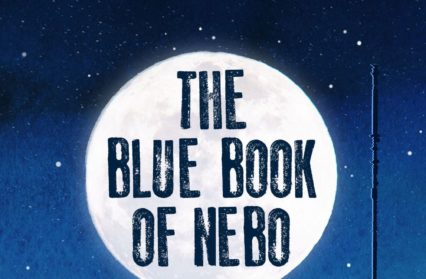Tilly Foulkes reviews The Blue Book of Nebo by Manon Steffan Ros, an English translation of Ros’ Welsh language novel Llyfr Glas Nebo.
If you went to school in Wales in the not-too-distant past, it’s likely you’ve encountered at least one book by Manon Steffan Ros. Her deeply original children’s and young adult fiction – all written in the medium of Welsh – dominate classrooms. She has for some time been a key figure in the Welsh-language literary world, captivating the scene since her arrival in the mid-to-late aughts, and she has won a multitude of awards in the process, inducing the National Eisteddfod’s Drama Medal two years in a row. The Blue Book of Nebo – translated by the author herself – is her first novel translated into English, and its Welsh original, Llyfr Glas Nebo, won the 2018 Prose Medal at the National Eisteddfod and the 2019 Welsh Book of the Year Award.
The Blue Book of Nebo is at once heart-warming and gut-wrenching. Taking the form of alternating diary entries by fourteen-year-old Dylan and his mam, Rowenna, it follows the story of a small family trying to survive in North West Wales post-apocalypse. The changing perspective between mother and son allows the reader to see this strange world through interchangeably curious and jaded eyes, the contrast regularly presenting moments of revelatory poignancy. Ros skilfully crafts these opposing viewpoints, their unique perspectives allowing her to weave in each character’s life experience. While an optimistic Dylan makes the most of the apocalyptic life he’s lived since childhood, he can’t help imagining the folkloric world which existed before “The End” with unsubstantiated nostalgia. Rowenna, on the other hand, is less sentimental about the old world. Hers was miserable, filled with absent fathers, tedium and money worries – in her new life she can, at least, solely focus on survival and her children. Dylan’s unwavering optimism in the face of relentless challenges is delicately handled and compelling to read. His perseverance hardly ever wavers, and it is only in moments of solitude that he allows his sadness to creep in, (one poignant example being the crush he develops on the photograph of a teenage girl, long-since gone, found in a deserted house). Ros also examines the isolation of motherhood through Rowenna’s melancholic narration, yet also represents her strength – her voice never veering towards a hyperbolic hopelessness. In fact, Dylan and Rowenna’s sincere love for each other provides the root of joy which runs throughout this novel.
The Blue Book of Nebo’s thorough appreciation for the Welsh language and Welsh literature is one of its prevalent themes, and most commendable features. It examines the common (though often difficult) relationship English-speaking Welsh parents have with their Welsh-speaking children; Dylan finds solace and escape in his Welsh books, and while Rowenna doesn’t speak Welsh fluently, she makes an effort to grant Dylan access to Welsh literature by stealing books from the abandoned houses of locals. Ultimately it is this thread which is used by Ros to demonstrate how pivotal literature is when it comes to connection; connecting with others, connecting with yourself, and connecting with personal culture and heritage. Still, it is a stark environment depicted by Ros. The bleakness of Dylan’s world is endless – there’s no one but his mother and baby sister in his life – and so literature and religion offer him a way to relate to things bigger than himself. This frequently renders him an endearing character – Dylan often comforts his mother by quoting Welsh writers to her, hoping this will console her in the same way it does him. A tender – though adolescent in nature – offer of hope. In the essentiality and urgency of Dylan’s need for connection, we see the importance of holding onto language as a personal as well as political matter. The intricate depiction of the mother-son relationship deftly wrapped up in the issue of Welsh language preservation.
This book is not only introspective but also intensely visual, its landscapes and horizons are treated with immense detail. Ros is particular when writing about the surrounding areas, honing a sincere appreciation for the land and its capture in language. Necessarily, setting is a fundamental element in any novel that tackles nuclear disaster; the ravaged landscapes provide a visual reminder of the carnage in which the characters now live. Yet, for Dylan and Rowenna, the land is also a meaningful way for them to relate to one another. Whether through the nurturing of vegetables, or Rowenna’s stories of life before “The End”, The Blue Book of Nebo is able to trace through different visions, both real and imagined, of a varying Welsh landscape.
The Blue Book of Nebo is a bleak novel, but not without its glimmers of optimism. A thought-provoking exploration of isolation, familial relations and Welsh language and culture, for a book light on plot, it’s emotional weight is considerable.
The Blue Book of Nebo by Manon Steffan Ros is available via Firefly.
You can read Manon Steffan Ros in conversation with Gary Raymond here.
Tilly Foulkes is a regular contributor to Wales Arts Review.











